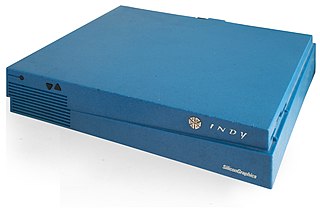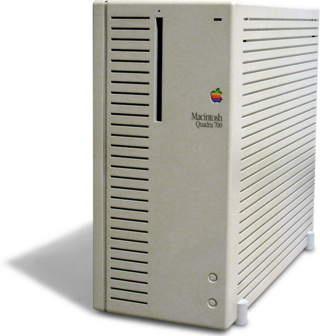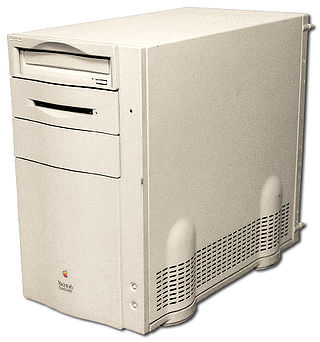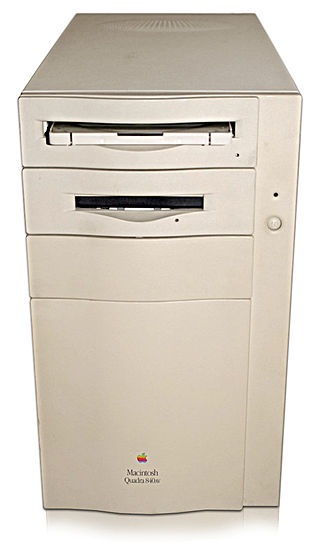
The Power Macintosh, later Power Mac, is a family of personal computers designed, manufactured, and sold by Apple Computer as the core of the Macintosh brand from March 1994 until August 2006.

The Macintosh II is a personal computer designed, manufactured, and sold by Apple Computer from March 1987 to January 1990. Based on the Motorola 68020 32-bit CPU, it is the first Macintosh supporting color graphics. When introduced, a basic system with monitor and 20 MB hard drive cost US$5,498. With a 13-inch color monitor and 8-bit display card the price was around US$7,145. This placed it in competition with workstations from Silicon Graphics, Sun Microsystems, and Hewlett-Packard.

The Macintosh IIsi is a personal computer designed, manufactured and sold by Apple Computer, Inc. from October 1990 to March 1993. Introduced as a lower-cost alternative to the other Macintosh II family of desktop models, it was popular for home use, as it offered more expandability and performance than the Macintosh LC, which was introduced at the same time. Like the LC, it has built-in sound support, as well as support for color displays, with a maximum screen resolution of 640 × 480 in 8-bit color.
Apple Inc. sold a variety of LCD and CRT computer displays in the past. Apple paused production of their own standalone displays in 2016 and partnered with LG to design displays for Macs. In June 2019, the Pro Display XDR was introduced, however it was expensive and targeted for professionals. Nearly three years later, in March 2022, the Studio Display was launched as a consumer-targeted counterpart to the professional monitor. These two are currently the only Apple-branded displays available.

The PowerBook Duo is a line of subnotebooks manufactured and sold by Apple Computer from 1992 until 1997 as a more compact companion to the PowerBook line. Improving upon the PowerBook 100's portability, the Duo came in seven different models. They were the Duo 210, 230, 250, 270c, 280, 280c, and 2300c, with the 210 and 230 being the earliest, and the 2300c being the final incarnation before the entire line was dropped in early 1997.

The Indy, code-named "Guinness", is a low-end multimedia workstation introduced on July 12, 1993. Silicon Graphics Incorporated (SGI) developed, manufactured, and marketed Indy as the lowest end of its product line, for computer-aided design (CAD), desktop publishing, and multimedia markets. It competed with Intel x86 computers, and with Windows and Macintosh, including using their files and running their applications via software emulation. It is the first computer to come standard with a video camera, called IndyCam. Indy was repackaged as a server model called Challenge S. Indy was discontinued on June 30, 1997 and support ended on December 31, 2011.

The Macintosh TV is a personal computer with integrated television capabilities released by Apple Computer in 1993. It was Apple's first attempt at computer-television integration. It shares the external appearance of the Macintosh LC 500 series, but in black. The Macintosh TV is essentially a Performa 520 that can switch its built-in 14" Sony Trinitron CRT from being a computer display to a cable-ready television. It is incapable of showing television in a desktop window, although it can capture still frames to PICT files.

The Apple Cinema Display is a line of flat-panel computer monitors developed and sold by Apple Inc. between 1999 and 2011. It was initially sold alongside the older line of Studio Displays, but eventually replaced them. Apple offered 20, 22, 23, 24, 27, and 30-inch sizes, with the last model being a 27-inch size with LED backlighting.

The Macintosh Quadra 700 was a personal computer designed, manufactured and sold by Apple Computer from October 1991 to March 1993. It was introduced alongside the Quadra 900 as the first computers in the Quadra series using Motorola 68040 processor, in order to compete with IBM compatible PCs powered by the Intel i486DX. The Quadra 700 is also the first computer from Apple to be housed in a mini-tower form factor, which in 1991 was becoming a popular alternative to standard desktop-on-monitor cases that were common through the 1980s.

The Macintosh Quadra 605 is a personal computer designed, manufactured, and sold by Apple Computer from October 1993 to July 1996. The model names reflect a decision made at Apple in 1993 to follow an emerging industry trend of naming product families for their target customers – Quadra for business, LC for education, and Performa for home. Accordingly, the Performa 475 and 476 was sold in department stores and electronics stores such as Circuit City, whereas the Quadra was purchased through an authorized Apple reseller.

The Macintosh Quadra 800 is a personal computer that is a part of Apple Computer's Quadra series of Macintosh computers.

The Power Macintosh 6200 is a series of personal computers designed, manufactured, and sold by Apple Computer from May 1995 to July 1997. The 6200 is the PowerPC-based replacement for the Quadra 630, with the same form factor and price range. In early 1997, the rather different Power Macintosh 6300/160 / Performa 6360 based on the Power Macintosh 6400 was introduced. The whole line was discontinued when the desktop model of the Power Macintosh G3 was released.

The Macintosh Quadra 840AV is a personal computer designed, manufactured, and sold by Apple Computer from July 1993 to July 1994. It was introduced alongside the Centris 660AV, where "AV" signifies audiovisual capabilities, such as video input and output, telecommunications, speech recognition, and enhanced audio. The 840AV has the same mini-tower form factor as the Quadra 800, with a faster Motorola 68040 processor.

The Macintosh Quadra 660AV, originally sold as the Macintosh Centris 660AV, is a personal computer designed, manufactured and sold by Apple Computer from July 1993 to September 1994. It was introduced alongside the Quadra 840AV; the "AV" after both model numbers signifies video input and output capabilities and enhanced audio.

The Macintosh Quadra 650, originally sold as the Macintosh Centris 650, is a personal computer designed, manufactured and sold by Apple Computer from February 1993 to September 1994. The Centris 650 was introduced alongside the smaller Centris 610 as the replacement for the Macintosh IIci and Quadra 700, and it was intended as the start of the new midrange Centris line of computers. Later in 1993, Apple decided to follow an emerging industry trend of naming product families for their target customers – Quadra for business, LC for education, and Performa for home – and folded the Centris 650 into the Quadra family.

The HDI-45 was one of Apple Computer's proprietary cable-to-onboard video connectors. A 45-pin connector, the HDI stands for High-Density Interconnect.
iXMicro, Inc., a privately held company, was a graphics chipset and video card manufacturer. The company was founded as Integrated Micro Solutions (IMS) in 1994 and ceased operations in 2000. The American actor Christopher Knight served as vice president of graphics marketing for iXMicro.

iMac is a family of all-in-one Mac desktop computers designed and built by Apple Inc. It has been the primary part of Apple's consumer desktop offerings since its debut in August 1998, and has evolved through seven distinct forms.

The Apple Studio Display is a series of non-widescreen LCD and CRT displays manufactured and sold by Apple Computer, Inc. and introduced in 1998. After the 1999 introduction of the widescreen Apple Cinema Display, the Apple Studio Display line ran concurrently until it was discontinued in 2004. With the exception of the last model, the 5:4 17" Apple Studio Display, all Apple Studio Displays had an aspect ratio of 4:3.
Apple Inc. has produced and sold numerous music and multimedia speakers, available for standalone purchase and bundled with Macintosh products.

















